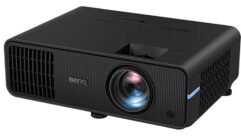
Expert Viewpoint: What’s in a Lamp?
Apr 1, 2008 12:00 PM,
By David Bethell
A look at the value-add commodity of projector lamps

The replacement lamp is a new option in the lamp-distribution industry. The bulbs are identical to the original lamp in the projector and supplied by the same bulb factory. Diamond Lamps, whose front-projection replacement module is pictured above, is one such supplier.
It has been more than 10 years since data projectors moved on from CRT to technologies that allowed more manageable units, and lamp technology also changed during that time — improving lifetime and brightness. Since then, there have been improvements to the lamp, but nothing to match the development of projectors — which are smaller, brighter, and more powerful, with extraordinary lens options and feature sets way beyond most of our wish lists, let alone our requirements.
Over the last few years, industry watchers have witnessed the commoditization of projectors with a mixture of incredulity and resignation at its speed and ruthlessness. What was once the darling of the AV industry, a big margin maker (complex to use, install, and maintain — a perfect vehicle for the value add of this service sector) is now the latest affordable, plug-and-play gizmo. With a price point that is affordable for consumers, the projector offers a fantastic, flexible viewing experience for both TV and gaming applications.
In fact, the projector has become so affordable at the lower end that it is in danger of becoming a disposable item. New models are available from many popular brands at less than $600, giving the consumer a difficult choice when faced with replacing a key component such as the lamp in an older machine or chucking the whole thing out and starting again.
Worth noting, however, is the fact that the lamp has not come down in price to the same extent as the projector. This vital component is an amazing feat of technology, which has to withstand enormous pressure (about 50 times more than a car tire) and unbelievable heat in excess of 8000 degrees Kelvin (that’s hotter than the sun), yet be easily replaceable by users.
Because the lamp is such an essential element of the projector’s performance, original bulb manufacturers work closely with projector manufacturers to ensure the lamp setup delivers the optimum performance within the projector setting. Throughout the manufacturing process, these original lamps undergo rigorous testing to ensure they meet quality and performance standards so the customer can be assured of a top-class solution. If the performance is not in line with the user expectation, then the brand reputation may well suffer.
Currently, industry experts estimate the replacement-lamp business is worth $1 billion worldwide. The business has changed radically over the last few years, beginning with the emergence of specialist lamp distributors who realized that the high cost and low availability of replacement projector lamps was driving users to flatscreen technologies.
These new specialist lamp distributors took it upon themselves to maintain large inventories of stock, which enabled fast and efficient delivery directly to the user. But the high-cost issue remained unresolved
The introduction of copy or compatible lamps — typically from the Far East, where the cost of production is low — combined with what could be described as a lax attitude toward copyright issues, eventually gave the market a cheap option, allowing the user perceived savings of up to 40 percent. When things are tough in the corporate world, the capital budget is the first to be slashed, and the maintenance budget — the pot raided for spare and replacement parts — normally has to bear its share of the brunt. So a reduction of the cost of a replacement lamp was, on the face of it, most welcome.
There are concerns over copy lamps, however. The first concern revolves around the fact that intellectual-poperty rights on projector bulb technology are held by the seven original bulb manufacturers: Philips, Osram, Phoenix, Ushio, Eye, Matsushita, and Epson. If a copy lamp is proved to have infringed on those rights, then anyone selling that lamp is commercially at risk of legal proceedings.

Philips test charts.
Click here for a larger image
Secondly, because copy lamps are not produced in conjunction with the development of leading projector brands, there is little guarantee that they will work well within the lamp setup of those projectors. Philips recently highlighted this issue with an independent test it commissioned in partnership with international consulting firm KEMA. Those tests concluded that copy bulbs measured far less bright compared to original Philips bulbs. So the cost saved at retail through the purchase of a copy bulb could well come at the expense of poor performance — particularly in terms of color, brightness, and lamp life. Thus, we would suggest that what was thought to be a bargain is actually a false economy.
Another option has opened up, however, with the introduction of a new category of replacement lamps, which use bulbs identical to the original lamp in the projector, supplied by the same bulb factory. Diamond Lamps, in Singapore, is an example of such a provider. What this new category offers is the performance and quality of the original bulb, but at a price competitive with copy or compatible lamps. To work effectively, this supply chain is quality controlled by the original bulb manufacturer, ensuring performance as good as the original without infringing upon any intellectual-property rights.
A potential issue with using these lamps, however, is the same issue that you can run into with copy/compatible lamps — the fact that the projector manufacturer may deem that their use invalidates the projector warranty. Whether or not the projector manufacturer would be able to legitimately enforce this remains to be proven, but many replacement lamps in this category are purchased for projectors that are no longer under warranty — in which case, this issue becomes irrelevant.
Today’s discerning projector user should be considering three things when replacing the lamp: cost, performance quality, and safety. They should also remember that the cost is not always measured up front. There is always a price to be paid for any compromise on performance and quality.
David Bethellis CEO of Just Lamps in the United Kingdom, a specialist lamp distributor?founded in 2002. He has more than 20 years of experience in the AV industry.










